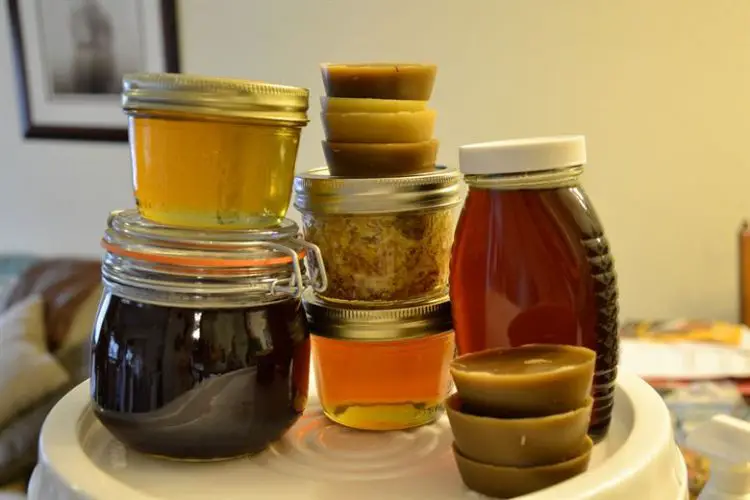In most supermarkets, we find row upon row of bottles of golden colored honey. However, honey actually comes in a myriad of colors, ranging from the transparent or “white” variety to the dark “deep amber”. There are also incidents of unusually colored honey, like red or blue-green. So the question that comes naturally is how does honey gets its color and why there is such a variety?
The color of the honey depends on the source that the bee is visiting. That means the nectar that the bees are using to make the honey is the primary influencer of the color the final product has. The minerals present in the floral source also have some impact on the color of the honey.
It is well known that bees visit a multitude of flowers to gather enough nectar for the honey in their hives. The kind of flowers and plants where the bees buzz is thus an important determining factor not only in terms of the flavor but also the color of honey. Here are some examples of how different plants produce different colored honey-
- Flowers- Honey that is produced from the nectar of the tiny white blueberry flowers is usually light amber in color.
- – In the state of California, bees visit the avocado blossoms to produce a honey that is dark colored.
- – This is the most common plant in the USA that produces nectar for honey. Depending on the variety of the clover and its location, the honey color can range from the transparent water white to pale amber to amber.
- – Produced extensively in the US states of Ohio, New York, Minnesota, Wisconsin, and Pennsylvania and in parts of Canada, buckwheat honey is dark colored and rich in taste.
- – Another very popular variety, sage honey is light in color and has a mild taste. Since it is slow to granulate, it is a favorite in the industry.
- – Honey from this plant is very common throughout Canada and in some parts of the USA. It is a mild tasting and light colored honey variety.
The color of honey can also change in color over time and depending on the temperature. For example, when exposed to high heat, light honey tends to turn a darker shade.
Over the years there have been reports in popular media of bees producing an unexpectedly colored honey. For example, in 2014, French beekeepers were astonished to find the bees producing blue-green honey. On further investigation, they figured out that the bees were feeding on a nearby M&M candy manufacturing plant and feeding off the blue candy shells. This incident further validates how the source of nectar for the bees dictates the honey color eventually.
Measuring the color of honey
The color of honey is typically measured using a continuous scale known as the Pfund scale of measurement. This scale consists of a glass wedge that varies in its color from lightest to darkest amber. The honey to be evaluated is poured into another wedge shaped container and then the color is compared with the amber scale. The place where the color of the honey matches closest to the scale is then marked as the result. The final measurement is thus given in a number ranging from 0 to 140 mm (according to the scale length where the match occurs)
The Association of Analytical Chemists implements another lesser used method called the Lovibond Visual Comparator. In this process, a light beam is shone through the honey and the color is compared to a scale for the final result.
Honey Color Classifications
Even though the color of honey is usually measured using a continuous scale, the US Department of Agriculture (USDA) classifies honey into the following seven color categories as per the measurement on the Pfund scale-
- Water white- <9 mm
- Extra white- 9 to 17 mm
- White- 18 to 34 mm
- Extra light amber- 35 to 50 mm
- Light amber- 51 to 85 mm
- Amber- 86 to 114 m
- Dark amber- >114 mm
In the classification, “white” in the first three categories refer to transparent honey rather than being actually white.
Does the color of honey affect the taste and quality?
The color of the honey most definitely has an impact on the quality, especially in terms of the taste. Usually, the lighter colored honeys have a milder taste while the darker honeys have a strong, full-bodied and rich flavor. However, there are exceptions to this rule like the light colored honey from basswoods or linden which have a strong flavor and the dark colored yet mild tasting tulip honey.
The color of the honey is also indicative of the antioxidant content of the product. Usually the darker the color, the higher the antioxidant content of the honey. For example, a study by the University of Illinois states that dark colored buckwheat honey has approximately 20 times more useful antioxidants than the light sage honey. Thus if you are looking to consume honey for health reasons, then this is an important point to consider while selecting the desired product.
Conclusion
Thus to answer the question- “where does honey get its color?”, one has to look at the source of the nectar. Bees throughout the world visit a multitude of flowering plants and shrubs to gather the nectar they require for producing the honey for their hives. Often nectar from multiple sources are used to produce the honey in a single hive and thus the color of the final product becomes a unique mixture of the sources. The minerals present in the nectar also influence the color to some degree. And if the bees visit an unusual source like in the case of the candy factory, beekeepers end up with an unexpectedly colored product.
Because of this, while choosing honey for consumption, one has a variety of choices available to them, not only in terms of the taste but also colors. A light colored honey goes well as a sweetener for foods like pancakes while a dark colored and rich honey can be used for its health boosting properties. Whatever the choice is, at the end of the day it is always a matter of personal likings.


![3 Big Mistakes Beginner Beekeepers Make [And How To Avoid Them!]](https://beekeepingabc.com/wp-content/uploads/2020/11/3-mistakes-beginner-beekeepers-make-90x75.jpg)

![Move over ducks, Queen Bees quack too! [Here’s Why]](https://beekeepingabc.com/wp-content/uploads/2020/06/queen-bee-90x75.png)
![The Flow Hive 2 Review [ Vs. The Classic Flow Hive]](https://beekeepingabc.com/wp-content/uploads/2020/02/Flow-Hive-2-90x75.jpg)
![How Bees Fly [10 Facts About How, When, and Why]](https://beekeepingabc.com/wp-content/uploads/2019/12/A-Bee-Flying-90x75.jpg)